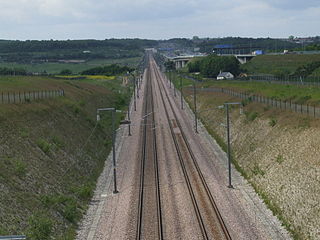
High Speed 1 (HS1), legally the Channel Tunnel Rail Link (CTRL), is a 109.9-kilometre (68.3-mile) high-speed railway linking London with the Channel Tunnel.
Maschinenbau Kiel GmbH was a German company that designed, manufactured and marketed marine diesel engines, diesel locomotives and tracked vehicles under the MaK brand name. The three primary operating divisions of Maschinenbau Kiel GmbH were sold to different companies in the 1990s.

The NS Class 6400 is a type of 4 axle diesel-electric freight locomotive. 120 were built by MaK and ABB between 1988 and 1994 for Nederlandse Spoorwegen.
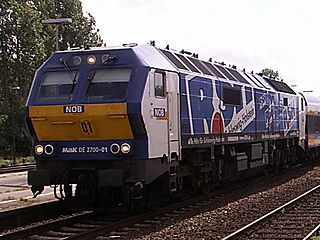
NSB Di 6, later designated ME 26 and DE 2700, is a class of twelve diesel-electric locomotives built by Siemens for the Norwegian State Railways (NSB). The prime mover provides a power output of 2,650 kilowatts (3,550 hp), a starting traction effort of 400 kilonewtons (90,000 lbf) and a maximum speed of 160 kilometres per hour (99 mph). They have a Co′Co′ wheel arrangement. The bidirectional locomotives were designed for use with both passenger and freight trains.

The NSB Di 8 is a class of diesel-electric locomotives built by Maschinenbau Kiel (MaK), while it was part of Siemens Schienenfahrzeugtechnik, for the Norwegian State Railways (NSB). The locomotives are equipped with a Caterpillar 3516 DI-TA prime mover, which provides a power output of 1,570 kilowatts (2,110 hp) and a starting tractive effort of 270 kilonewtons (61,000 lbf).

These DB Class V 100 diesel locomotives were produced in the late 1950s by the Deutsche Bundesbahn for non-electrified branch lines as a replacement for steam locomotives. The V 100 class was built in three different variants.

The Voith Gravita locomotives are a family of road switcher diesel-hydraulic locomotives built by Voith Turbo Lokomotivtechnik GmbH & Co. KG. Available in a range of configurations from 4 to 6 axles, they are designed for shunting and light and medium freight operations.
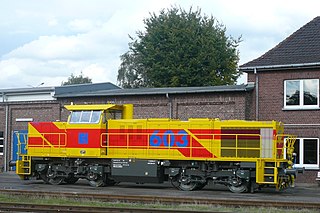
The Vossloh G1206 is a B'B' diesel hydraulic freight locomotive built in Kiel and used by several European railway operators including a SNCF specific variant the BB 461000 series.
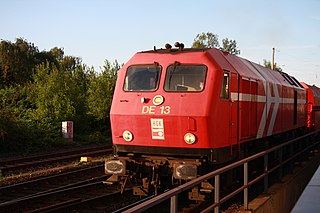
The DB Class 240 are a class of Co′Co′ diesel-electric locomotives which were produced in the 1980s by MaK in collaboration with Krupp and ABB as DE 1024 as prototypes/technology demonstrators for a possible future order from the Deutsche Bundesbahn.

The DB Class V 51 and DB Class V 52 are classes of almost identical narrow gauge 4 axle diesel hydraulic locomotives built in 1964 for the Deutsche Bundesbahn, being built for 750 mm and 1,000 mm gauge lines respectively.

The MaK G 1204 BB is a four axle B'B' diesel-hydraulic locomotive with and off centre cab design built by MaK in Kiel, Germany. Eighteen of these light freight and shunting locomotives were built which were used mostly on German industrial railways, two units have worked for the Swiss Federal Railways and received the class designation Am 842.
Europorte Channel is a rail freight train operator which operates rail freight services between France and the United Kingdom through the Channel Tunnel. It is a subsidiary of Europorte.

The Vossloh G1700 BB is a four axle B′B′ medium power diesel-hydraulic locomotive manufactured by Vossloh Locomotives GmbH. in Kiel.
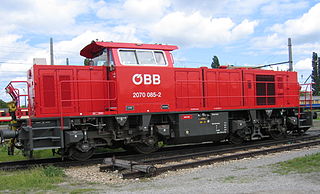
The ÖBB 2070 is a class of 90 shunting and light multipurpose four axle B'B' Diesel-hydraulic locomotive built for the Austrian Federal Railways by Vossloh at the MaK locomotive plant in Kiel, Germany.

The MaK G 1201 BB is a four axle B'B' diesel-hydraulic off-centre cab locomotive built by the Maschinenbau Kiel in German. The locomotive is designed for shunting and freight work, such as found on industrial railways.

The MaK DE 1002 is a class of 4 axle Bo′Bo′ diesel-electric locomotives built by Maschinenbau Kiel in association with Brown, Boveri & Cie.

The British Rail Class 373, known in France as the TGV TMST and branded by Eurostar as the Eurostar e300, is a French designed and Anglo-French built electric multiple unit train that was used for Eurostar international high-speed rail services from the United Kingdom to France and Belgium through the Channel Tunnel. Part of the TGV family, it was built with a smaller cross-section to fit the smaller loading gauge in Britain, was originally capable of operating on the UK third rail network, and has extensive fireproofing in case of fire in the tunnel. It is both the second longest—387 metres —and second fastest train in regular UK passenger service, operating at speeds of up to 300 kilometres per hour (186 mph).

Iris 320 is a modified TGV train operated by SNCF International as a dedicated track recording train for high-speed railways. The train can run at 320 kilometres per hour (199 mph) and consists of two power cars and eight trailer coaches, providing a 160-metre long laboratory. It was converted from former SNCF TGV Réseau passenger train number 4530.

The Vossloh G6 is a C diesel-hydraulic shunting locomotive, and the first locomotive of Vossloh's fifth generation programme. The G6 is the successor of the MaK/Vossloh G765, a third generation MaK locomotive still offered in the 2000s.

The second use of the TOPS classification Class 21 for locomotives used on the British railway network came through the use of a number of related diesel-hydraulic and diesel-electric locomotives procured following the opening of the Channel Tunnel. The total of 16 locomotives were obtained by two separate operators, with some used for freight, and others to propel service trains and as "Thunderbird" locomotives.


















